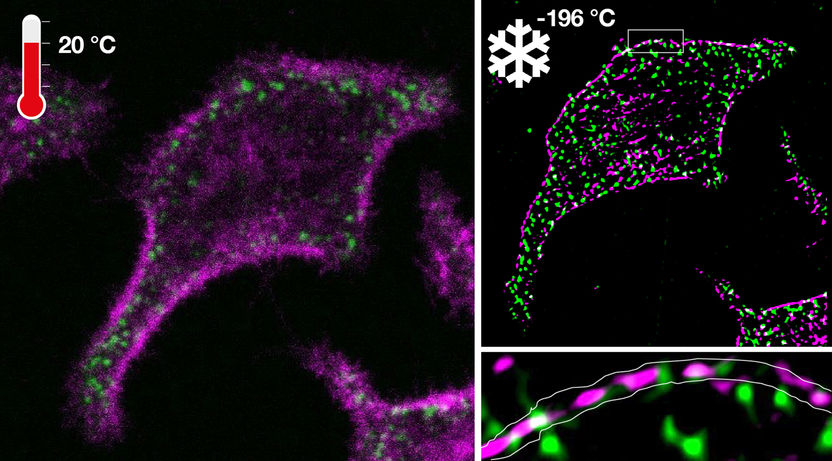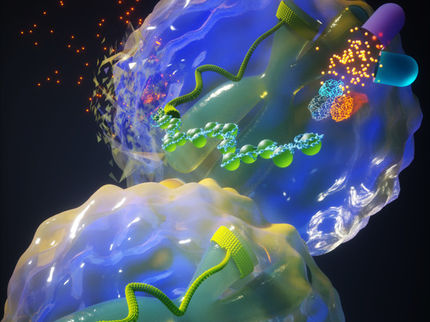Mathematical and biochemical 'design features' for cell decoding of pulses revealed
Every cell in the body has to sense and respond to chemicals such as hormones and neurotransmitters. They do so by relaying information from receptors to intracellular biochemical pathways that control cell behaviour, but relatively little is known about how cells decode the information in dynamic stimuli.
A team of researchers have found that differences in response kinetics working down the intracellular signalling pathway dictate differential sensitivity to different features of pulsatile hormone inputs.
The study funded by the BBSRC and published in the Journal of Biological Chemistry, explored mechanism underlying dynamic gonadotropin-releasing hormone (GnRH) signalling using live cell imaging and mathematical modelling.
The research team, led by Craig McArdle, Professor of Molecular Pharmacology at the University of Bristol's School of Clinical Sciences, in collaboration with the University of Exeter, focused on the ERK signalling pathway as this enzyme is activated by GnRH pulses and is essential for normal reproduction.
The neuropeptide hormone GnRH is secreted in pulses from neurons in the hypothalamus and controls secretion of two pituitary hormones, the LH and FSH that, in turn, control production of germ cells and sex steroids.
This system provides the interface between the brain and the reproductive system. It is absolutely essential for normal reproduction and is targeted therapeutically in assisted reproduction and in the treatment of hormone-dependent diseases, such as breast and prostate cancer.
The study found that for effects on gene expression the system is more sensitive to changes in GnRH receptor number than it is to changes in GnRH concentration, and is more sensitive to changes in GnRH interval than it is to changes in GnRH pulse width.
Professor Craig McArdle said: "The work revealed "design-features" of the system that make perfect sense in light of the biology, where GnRH receptor number and GnRH pulse interval vary, for example, through puberty and through the menstrual cycle.
"These features are relevant to numerous biological systems using pulsatile stimuli and suggest intriguing mechanisms for differential control of rapid and delayed responses with dynamic stimuli."
Professor Krasimira Tsaneva-Atanasova, Associate Professor of Mathematics at the University of Exeter and co-author on the paper said: "The effects of a signalling molecule can be fast or slow and the same signalling molecule will often elicit a rapid, transient response from a cell followed by a slower, long term change in cell behaviour.
"How fast and slow molecular pathways are modulated by pulsatile, or dynamic, inputs is particularly important for understanding GnRH signalling in physiologically relevant stimulation paradigms and identifying new tools that could be used for fertility control and treatment of hormone-dependent cancer."
Billions are spent every year on GnRH receptor ligands and the stimulation paradigm is absolutely crucial for therapeutic applications, but remarkably little is known about how the target cells and tissues decode GnRH dynamics.
The work is strengthened by the collaboration between the University's School of Clinical Sciences and School of Mathematics together with the Department of Maths at the University of Exeter, and the study illustrates the additional insight to be gained from such collaborative "maths-driven biology".
Most read news
Topics
Organizations
Other news from the department science

Get the life science industry in your inbox
By submitting this form you agree that LUMITOS AG will send you the newsletter(s) selected above by email. Your data will not be passed on to third parties. Your data will be stored and processed in accordance with our data protection regulations. LUMITOS may contact you by email for the purpose of advertising or market and opinion surveys. You can revoke your consent at any time without giving reasons to LUMITOS AG, Ernst-Augustin-Str. 2, 12489 Berlin, Germany or by e-mail at revoke@lumitos.com with effect for the future. In addition, each email contains a link to unsubscribe from the corresponding newsletter.
Most read news
More news from our other portals
Last viewed contents
Guillain-Barré_syndrome
Acid-fast
Proline
Pregnancy
Category:Transcription_coregulators

Cool Microscopy: Making the invisible visible - Ultrarapid cooling enables the observation of molecular patterns of life























































